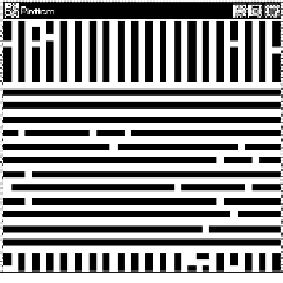Information Technology Reference
In-Depth Information
Fig. 4.
Two Behaviors Evolved in a Dissipative Cellular Automata. Despite the out-
of-equilibrium situation forced by the external environment, stable large-scale and
symmetry-breaking patterns emerge.
For example, Fig. 4 shows two different patterns emerged from a DCA, both
exhibiting stable macro-level spatial structures. For this DCA, the transition
rules and the neighborhood structure are the one described in Subsect. 2.1.
In both cases, the presence of global scale patterns - breaking the rotational
symmetry of the automata - is apparent. By comparing these patterns with the
ones observed in the same CA under asynchronous but close dynamics, one can
see that openness has provided for making small scale patterns, emerged from
local transition rules, enlarge to the whole CA size. Once this global states has
emerged, they are able to restabilize autonomously, despite the fact that the
perturbing effects tends to modify them.
As another example, Fig. 5 shows two typical patterns emerged for a DCA
with a neighborhood structure made up of 12 neighbors (the neighbors of a cell
are all cells having a maximum distance of 2 from the cell itself)and with the
following transition rule:
f
=
{
a dead cell gets alive iff it has 6 neighbors alive; a living cells lives iff it
has 3,4,5, or 6 neighbors alive
}
Again, it is possible to see large symmetry-breaking patterns emerge, extending
to a global scale the local patterns that tends to emerge under asynchronous
but closed regime (Fig. 6). The patterns are stable despite the continuous per-
turbing effect of the environment. Moreover, the pattern shown on the left of
Fig. 5 is dynamic. First, the long diagonal stripes change continuously in their
microlevel shape, while maintaining the same global structure. Second, all this
stripes translate horizontally at a constant speed in the DCA lattice.
DCA share common characteristics with
Stochastic Cellular Automata
[2,
14]). Stochastic Cellular Automata (SCA) are synchronous CA with a transi-
tion function characterized by an
outgoing probability distribution
, which biases
the choice of the next cell's state. The main difference between DCA and SCA








